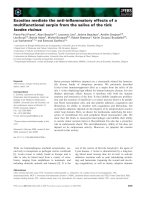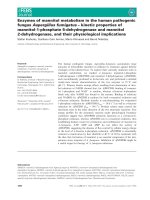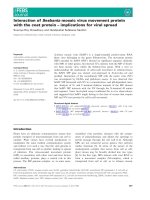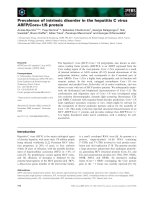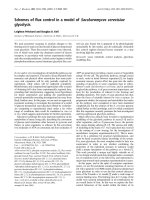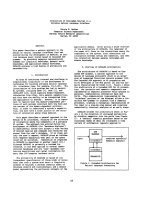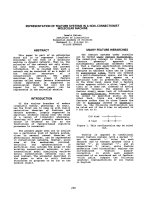Báo cáo khoa học: "Adenocarcinoma of the third portion of the duodenum in a man with CREST syndrome" pot
Bạn đang xem bản rút gọn của tài liệu. Xem và tải ngay bản đầy đủ của tài liệu tại đây (349.23 KB, 4 trang )
BioMed Central
Page 1 of 4
(page number not for citation purposes)
World Journal of Surgical Oncology
Open Access
Case report
Adenocarcinoma of the third portion of the duodenum in a man
with CREST syndrome
Georgios Anastasopoulos, Athanasios Marinis*, Christos Konstantinidis,
Theodosios Theodosopoulos, Georgios Fragulidis and Ioannis Vassiliou
Address: Second Department of Surgery, Areteion University Hospital, 76 Vassilisis Sofia's Ave, 11528, Athens, Greece
Email: Georgios Anastasopoulos - ; Athanasios Marinis* - ;
Christos Konstantinidis - ; Theodosios Theodosopoulos - ;
Georgios Fragulidis - ; Ioannis Vassiliou -
* Corresponding author
Abstract
Background: CREST (Calcinosis, Raynaud's phenomenon, Esophageal dysmotility, Sclerodactyly
and Telangiectasias) syndrome has been rarely associated with other malignancies (lung,
esophagus).This is the first report of a primary adenocarcinoma of the third portion of the
duodenum in a patient with CREST syndrome.
Case presentation: A 54-year-old male patient with CREST syndrome presented with colicky
postprandial pain of the upper abdomen, diminished food uptake and a 6-Kg-body weight loss
during the previous 2 months. An ulcerative lesion in the third portion of the duodenum was
revealed during duodenoscopy, with a diagnosis of adenocarcinoma on biopsy specimen histology.
The patient underwent a partial pancreatoduodenectomy. No adjuvant therapy was instituted and
follow-up is negative for local recurrence or metastases 21 months postoperatively.
Conclusion: CREST syndrome has been associated with colon cancer, gastric polyps, familial
adenomatous polyposis (FAP) syndrome and Crohn's disease; however, this is the first report of a
primary adenocarcinoma of the duodenum in a patient with CREST syndrome. However, any
etiologic relationship remains to be further investigated.
Background
CREST syndrome (Calcinosis, Raynaud's phenomenon,
Esophageal dysmotility, Sclerodactyly and Telangiecta-
sias) has been rarely associated with other malignancies
(lung, esophagus), whereas duodenal adenocarcinoma
has never been reported to be associated with this subtype
of systemic sclerosis [1-3]. This is the first report of a pri-
mary adenocarcinoma of the third portion of the duode-
num in an adult male patient with CREST syndrome.
Case presentation
A 54-year-old man was referred to our clinic because of
colicky postprandial pain of the upper abdomen during
the last month, with aggravation 5 days before admission.
The patient had diminished the amount of food uptake
and had also a 6-Kg-body weight loss during the previous
2 months. His past medical history included CREST syn-
drome under cortisone therapy during the last year and
primary repair of the left ureter and the small intestine
Published: 1 October 2008
World Journal of Surgical Oncology 2008, 6:106 doi:10.1186/1477-7819-6-106
Received: 3 June 2008
Accepted: 1 October 2008
This article is available from: />© 2008 Anastasopoulos et al; licensee BioMed Central Ltd.
This is an Open Access article distributed under the terms of the Creative Commons Attribution License ( />),
which permits unrestricted use, distribution, and reproduction in any medium, provided the original work is properly cited.
World Journal of Surgical Oncology 2008, 6:106 />Page 2 of 4
(page number not for citation purposes)
due to traumatic perforation in a car accident 17 years ago.
Physical examination revealed a pale, malnourished
patient and an unremarkable abdomen without tender-
ness or distension. Besides an anemia, the other blood
investigations, as well as tumor markers, were within nor-
mal limits. Plain abdominal radiographs showed no path-
ological findings, while contrast-enhanced series
demonstrated a stricture in the transition area from the
second to the third portion of the duodenum (Figure 1).
Abdominal computed tomography showed a mass in the
duodenum, without evidence of metastases (Figure 2).
Thorax computed tomography was negative for metas-
tases as well. Gastroduodenoscopy revealed an ulcerated
lesion between the second and third portion of the duo-
denum and the biopsies showed an adenocarcinoma.
Colonoscopy was normal.
Laparotomy, through a bilateral subcostal incision,
revealed a large tumor locally invading the third portion
of the duodenum and possibly the pancreas. Therefore, a
partial pancreatoduodenectomy (Whipple's procedure)
was carried out. Histological examination revealed a low-
grade duodenal adenocarcinoma of maximal diameter 4
cm, which infiltrated the duodenal wall and the fibro-adi-
pose tissue of the mesentery. Metastasis was found in one
out of ten lymph nodes examined, while the surgical mar-
gins were negative for microscopic disease.
The patient's postoperative course was complicated with a
peripancreatic-remnant collection and a lower respiratory
infection, which were treated conservatively.
No additional therapy was instituted and 21 months after
the operation the patient is alive, without any evidence of
local recurrence or metastases.
Discussion
Primary duodenal adenocarcinoma represents a relatively
rare clinical entity. Duodenum constitutes the most pre-
dominant site (55%) of occurrence of adenocarcinoma
throughout the small intestine, followed by the jejunum
(18%) and ileum (13%) [4]. The distribution pattern of
adenocarcinoma within the duodenum is reported to par-
allel the length of each portion. The first portion is
affected in 15%, the second portion in 40% and the third
and fourth portion in 45% of the cases [5].
Most of these neoplasms are asymptomatic until they
become large in size. Partial duodenal obstruction, with
associated symptoms of crumpy postprandial pain of the
upper abdomen, nausea and vomiting, is the most com-
mon mode of presentation. Hemorrhage, usually indo-
lent, is the second most common mode of presentation.
Due to their location these tumors cause non-specific and
vague symptoms leading to a delay of diagnosis [6]. Peri-
Barium upper GI series showing a stricture (arrow) in the transition of the second to the third portion of the duode-numFigure 1
Barium upper GI series showing a stricture (arrow)
in the transition of the second to the third portion of
the duodenum.
Computed tomography of the abdomen depicting a mass (arrows) in the duodenumFigure 2
Computed tomography of the abdomen depicting a
mass (arrows) in the duodenum.
World Journal of Surgical Oncology 2008, 6:106 />Page 3 of 4
(page number not for citation purposes)
ampullary tumors may cause obstructive jaundice or pan-
creatitis.
Barium upper GI series and endoscopy of the upper gas-
trointestinal (GI) tract establish the diagnosis with a sen-
sitivity of 81,9% and 88%, respectively [7], while
colonoscopy and thoraco-abdominal computed tomogra-
phy are carried out to exclude any synchronous or meta-
static cancer.
The only possibility of cure is obtained by a radical resec-
tion. The percentage of resectability with a curative intent
is reported to range from 50% to 73% [7]. For the tumors
located in the first and the second portion of the duode-
num, a Whipple's procedure is considered necessary for
the radical resection of the tumor and its lymphatic drain-
age. For tumors of the third and fourth portion, a segmen-
tal resection of the duodenum with the appropriate
lymphadenectomy is performed with a curative intent [8].
Chemotherapy and radiation are considered to have only
a small contribution to the overall survival or the disease-
free survival of these patients [9].
Primary duodenal adenocarcinoma is an aggressive tumor
with an overall 5-year survival rate of about 25% [7],
which can be significantly improved up to 54% after cur-
ative resection [8]. The most important prognostic factors
are the stage of the disease and the location of the tumor.
Tumors with negative margins in the surgical specimen,
which are located in the first and second portions of the
duodenum, are considered to have a better prognosis.
Other series report that histologic grade, depth of inva-
sion, tumor size and metastases to regional lymph nodes
influence the survival rate [7-10].
Primary duodenal adenocarcinoma has been associated
with colon cancer, gastric polyps, especially villous and
tubulovillous adenomas, familial adenomatous polyposis
(FAP) and Crohn's disease. It has been stated that primary
duodenal adenocarcinoma is one of the main causes of
death in patients with FAP [11]. A case of an early duode-
nal adenocarcinoma from a Brunner's gland has been
reported [12]. Another case of primary duodenal adeno-
carcinoma in a patient with neurofibromatosis type 1 has
also been reported [13].
Limited cutaneous scleroderma or CREST syndrome con-
sists one of the two main subsets of systemic sclerosis,
which is a multisystemic disorder of unclear pathogenesis,
characterized by inflammatory, vascular and fibrotic
changes of the skin and various internal organ systems (GI
tract, lungs, heart and kidneys) and involves immuno-
logic mechanisms leading to vascular endothelial damage
and fibroblast activation. CREST syndrome consists of cal-
cinosis, Raynaud's phenomenon, esophageal dysmotility,
sclerodactyly and telangiectasias and is associated with a
better prognosis [14].
The association of this syndrome with malignancies is
extremely rare. A case of CREST syndrome and adenocar-
cinoma of the lung has been reported [1]. It is also sug-
gested that patients with scleroderma and Barrett's
metaplasia have an increased risk of complications, such
as strictures or adenocarcinoma [2]. Another case of pro-
gressive systemic sclerosis (CREST syndrome), sarcoidosis
and esophageal adenocarcinoma in a 50-year-old Japa-
nese female has been reported [3]. Finally, we report the
first case of a male patient with CREST syndrome and duo-
denal adenocarcinoma.
Conclusion
A relationship between duodenal adenocarcinoma and
limited cutaneous scleroderma has not yet been described
and in our case is considered a matter of coincidence.
Whether underlying mechanisms exist (immunologic,
genetic, etc) remains to be elucidated with further
research.
Competing interests
The authors declare that they have no competing interests.
Authors' contributions
GA, IV and CK carried out the surgical procedure and con-
tributed to the design of the study; GA and AM gathered
the data, drafted the manuscript and critically revised it;
IV, TT and GF revised and finally approved the manuscript
for been published. All authors read and approved the
final manuscript.
Consent
Written informed consent was obtained from the patient
for publication of this case report and any accompanying
images. A copy of the written consent is available for
review by the Editor-in-Chief of this journal.
References
1. Salvant EE, Carter JM, Armstrong EM, Polk OD Jr, Austin KI: CREST
syndrome: a variant of progressive systemic sclerosis, associ-
ated with interstitial pulmonary fibrosis and malignancy.
South Med J 1988, 81:1185-1187.
2. Katzka DA, Reynolds JC, Saul SH, Plotkin A, Lang CA, Ouyang A,
Jimenez S, Cohen S: Barrett's metaplasia and adenocarcinoma
of the esophagus in scleroderma. Am J Med 1987, 82:46-52.
3. Maenawa Y, Nogami R: A case of progressive systemic sclerosis
associated with sarcoidosis and esophageal adenocarcinoma.
J Dermatol 1993, 20:45-48.
4. Howe JR, Kamel LH, Menck HR, Scott-Conor C: Adenocarcinoma
of the small bowel. Review of the National Cancer Data
Base, 1985–1995. Cancer 1999, 86:2593-2706.
5. Coit DG: Cancer of the small intestine. In Cancer: Principles and
Practice of Oncology Edited by: De Vita Jr VT, Hellman S Rosenberg SA.
Philadelphia: Lipincott, Williams & Wilkins; 2001:1204-1206.
6. McCarron EC, Gibbs J, Fakih M, Nava HR, Rajput A: Duodenal ade-
nocarcinoma: vague complaints, delayed diagnosis and poor
outcome. Proceedings in the ASCO (Gastrointestinal Cancers Sympo-
sium) 2004, 171A:.
Publish with BioMed Central and every
scientist can read your work free of charge
"BioMed Central will be the most significant development for
disseminating the results of biomedical research in our lifetime."
Sir Paul Nurse, Cancer Research UK
Your research papers will be:
available free of charge to the entire biomedical community
peer reviewed and published immediately upon acceptance
cited in PubMed and archived on PubMed Central
yours — you keep the copyright
Submit your manuscript here:
/>BioMedcentral
World Journal of Surgical Oncology 2008, 6:106 />Page 4 of 4
(page number not for citation purposes)
7. Sohn TA, Lillemoe KD, Cameron JL, Pitt HA, Kaufman HS, Hruban
RH, Yeo CJ: Adenocarcinoma of the duodenum: factors influ-
encing long-term survival. J Gastrointest Surg 1998, 2:79-87.
8. Bakaeen F, Murr MM, Sarr MG, Thompson GB, Farnell MB, Nagorney
DM, Farley DR, van Heerden JA, Wiersema LM, Schleck CD, Dono-
hue JH: What prognostic factors are important in duodenal
adenocarcinoma? Arch Surg 2000, 135:635-642.
9. Tocchi A, Mazzoni G, Puma F, Mizzini M, Cassini D, Bettelli E,
Tagliacozzo S: Adenocarcinoma of the third and fourth por-
tions of the duodenum: results of surgical treatment. Arch
Surg 2003, 138:80-85.
10. Ryder NM, Ko CY, Hines OS, Gloor B, Reber HA: Primary duode-
nal adenocarcinoma: a 40-year experience. Arch Surg 2000,
135:1070-1075.
11. Groves CJ, Saunders BP, Spigelman AD, Phillips : Duodenal cancer
in patients with familial adenomatous polyposis (FAP):
results of a 10-year prospective study. Gut 2002, 50:636-641.
12. Akino K, Kondo Y, Ueno A, Yamazaki K, Hosokawa M, Shimozi H,
Adachi T, Honda S, Ichiyanagi S, Akahonai Y, Fujisawa Y, Takahashi H,
Arimura Y, Endo T, Imai K: Carcinoma of duodenum arising
from Brunner's gland. J Gastroenterol 2002, 37:293-296.
13. Joo YE, Kim HS, Choi SK, Rew JS, Park CS, Kim SJ: Primary duode-
nal adenocarcinoma associated with neurofibromatosis type
1. J Gastroenterol 2002, 37:215-219.
14. Fauci AS, Braunwald E, Isselbacher KJ, Wilson JD, Martin JB, Kasper
DL, Hauser SL, Longo DL: Systemic Sclerosis (Scleroderma). In
Harrison's Principles of Internal Medicine. Companion Handbook
McGraw-Hill International Editions; 1998:880-882.


